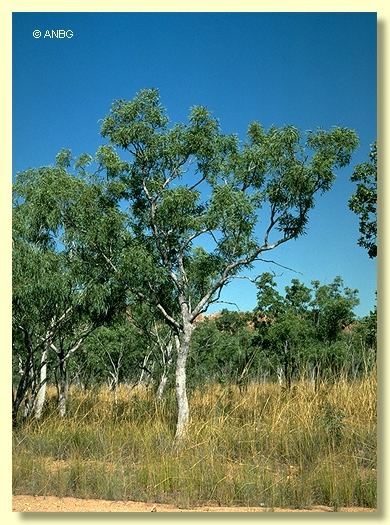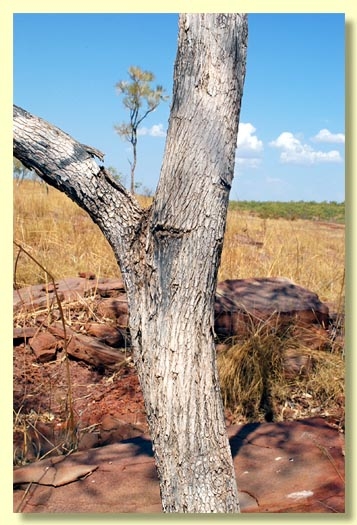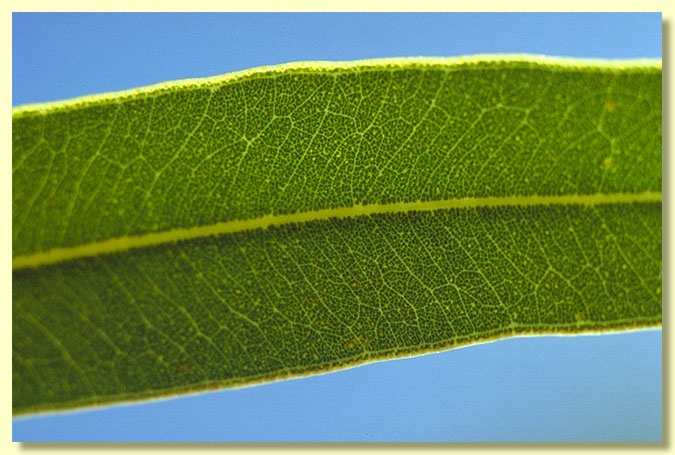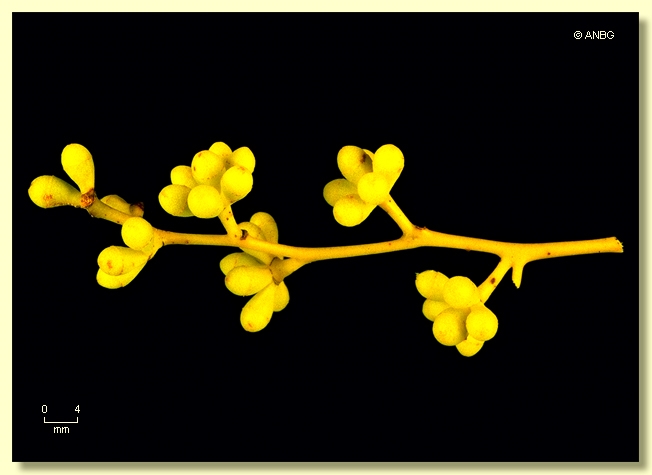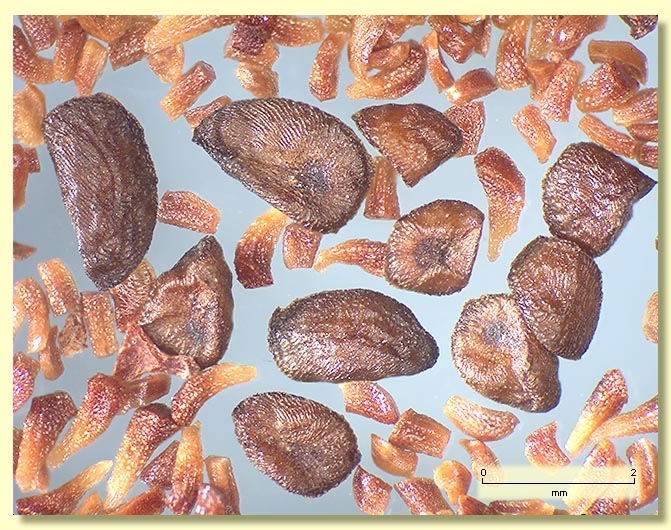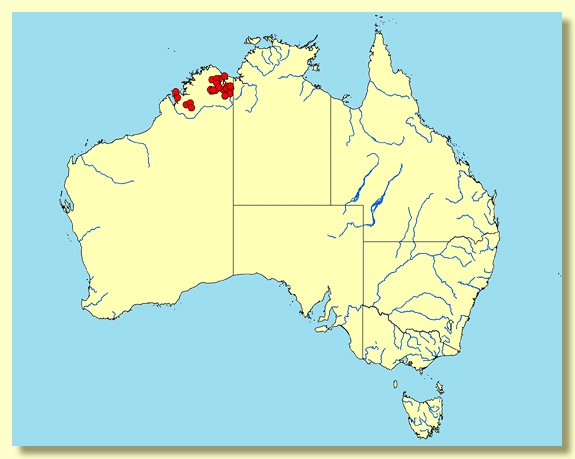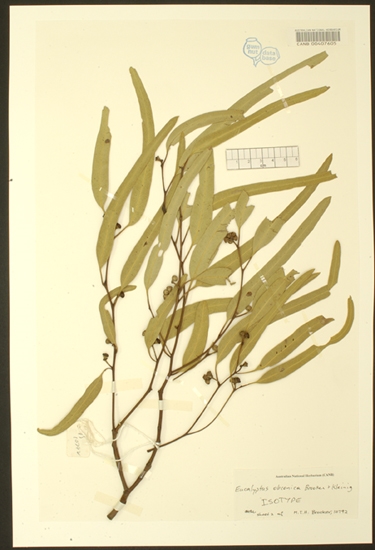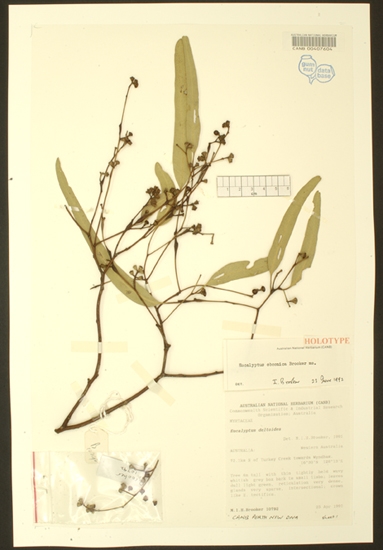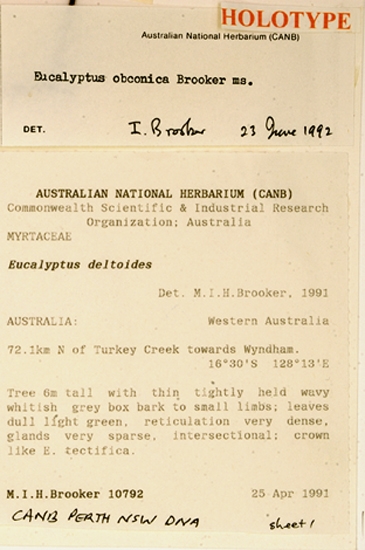Eucalyptus | Symphyomyrtus | Adnataria | Apicales | Aquilonares | Protrusae
Euclid - Online edition
Eucalyptus obconica
Small tree with a short trunk,or mallee, to 8 m tall. Forming a lignotuber.
Bark.rough to small branches, box-type or sometimes tessellated, light grey-brown to grey-white.
Branchlets lack oil glands in the pith; non-glaucous.
Juvenile growth (coppice or field seedlings to 50 cm): stems rounded in cross-section; juvenile leaves always petiolate, alternate, broadly lanceolate, to 13 cm long, to 3.5 cm wide, dull, light green.
Adult leaves alternate, petioles 0.5–2 cm long; blade lanceolate to falcate or ± oblong, (5.3)6–15.5 cm long, 0.5–2 cm wide, base tapering to petiole, apex rounded or pointed, margin entire, concolorous, dull, light green to bluish green, side-veins usually at 45° or more to midrib, reticulation very dense, intramarginal vein present close to margin, oil glands scattered, intersectional and island.
Inflorescence terminal compound, sometimes a few single umbels in the axils below or even a few compound axillary also, peduncles angular, 0.2–0.8 cm long, buds 7 per umbel, sessile or rarely subsessile (pedicel never > 0.1 cm). Mature buds ovoid to obovoid, sometimes basally slightly angled, 0.4–0.5 cm long, 0.3–0.4 cm wide, scar present (outer operculum shed early), operculum rounded, sometimes apiculate, to conical, stamens irregularly flexed, all fertile, anthers adnate, basifixed, cuboid to globoid, dehiscing by lateral slits, style long, straight, stigma blunt, locules 3 or 4(5), the placentae each with 4 vertical ovule rows. Flowers white.
Fruit sessile to subsessile, obconical, 0.2–0.4 cm long, 0.3–0.5 cm wide, rim thin and sometimes split, disc level or descending obliquely, valves 3 or 4(5), at rim level or exserted.
Seeds dark brown to blackish brown, 1–2.3 mm long, flattened-ovoid, sometimes pointed at one end, dorsal surface shallowly reticulate, hilum ventral.
Cultivated seedlings (measured at ca node 10): cotyledons reniform; stems rounded in cross-section; leaves very shortly petiolate (petioles 0.1–0.6 cm), opposite for 6–10 nodes then becoming alternate, linear, 6.5–10.5(14.5) cm long, 0.3–0.6(1) cm long, base tapering, apex pointed, dull, green, concolorous.
Flowering has been recorded in March.
A small tree or mallee endemic to the Kimberley region of Western Australia, distributed from the Carr Boyd Ranges and west of Kununurra to Napier Downs, Kimbolton and Koolan Island, occurring on elevated rocky plateau sites with shallow soil. It has rough bark to the branches, dull greenish crown of slender lanceolate leaves, blunt sessile buds and small obconical fruit.
Eucalyptus obconica is unlikely to be confused with any other species within its natural range. It is most closely related to the box species E. argillacea from plains in the Mt House area of the Kimberley region, which differs in having longer buds and fruit that are pedicellate and also glaucous branchlets, leaves, buds and fruit. It is also close to E. tectifica, Darwin box, which is widespread on plains throughout savannah areas of north-western Australia and which differs also in having pedicellate buds and fruit with the fruit being slightly larger, thin-walled and lacking exserted valves.
In the classification of Brooker (2000) Eucalyptus obconica belongs in Eucalyptus subgenus Symphyomyrtus section Adnataria (the boxes) because the buds have two opercula, ovules are in four rows, seeds are flattened-ovoid, cotyledons are reniform, and anthers are rigid on the staminal filaments.
Eucalyptus obconica: Latin obconicus, obconical, referring to the shape of the fruit.


